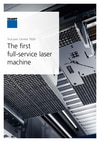What do autonomous machines mean for your production?
The age of intelligent production is already underway. TRUMPF machines are increasingly independent in their operation; they analyze and regulate processes. With your help, malfunctions can be prevented, and productivity can be increased. Employees can already be supported and relieved during many operations even today. Laser cutting will also become easier and less stressful in the future. Interested in learning the advantages that integrating autonomous and partially autonomous technologies can bring to your 2D laser processing? Click on the green dots in the image to find out more.

1. Fewer reject parts
Nip rejects in the bud: the sensor system can detect low quality materials or contaminations, thereby preventing cutting flaws before they occur.
2. Intuitive machines
Many malfunctions are detected or prevented through intelligent assistance systems. The Touchpoint HMI user interface allows machines to be operated more intuitively. Additional autonomous laser cutting functions can also be simply installed via software updates in the future
3. Transparent processes
This is how free of stress work can be: information or error messages are sent quickly and simply on the go, to a tablet or smartphone. The operator is informed whether manual intervention is required.
4. Relieved operators
While the cutting process is running smoothly, the operator has time for other tasks, for example material logistics or work preparations. This enables maximum productivity and machine utilization.
5. Error-free night shifts
Partially autonomous functions and automation components allow for stable production with minimal monitoring – even during night shifts with fewer personnel.
6. Maintenance and setup can be planned
In the future, it will be possible for autonomous laser cutting machines to recommend and control maintenance, as well as diagnose setup requirements on their own. Our services are already allowing for easy ordering and quick availability of consumables.
7. Speeds far beyond default values
Active Speed Control renders the need to take buffers into account redundant. The sensor system allows the machine to work as quickly as possible, and with as much process reliability as necessary, respectively. Often speeds are achieved which are significantly higher than the default values contained in the cutting data.
8. Automatic post-production
In the future, highly autonomous and fully autonomous laser cutting machines will automatically determine restart strategies after remedying a malfunction. This enables automatic post-production.
9. Less reworking
Active Speed Control determines the optimal feed rate and adjusts this if required, even if sheet thickness varies. In many cases this reduces the amount of burr and dross build-up.
Something to consider
Curious about the future of laser processing?
What does autonomous laser cutting mean for your parts production? What benefits are there to you? Our 2D laser cutting experts would be happy to answer these as well as other questions.




